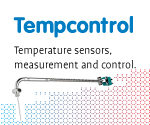A thermistor is a type of resistor whose resistance varies significantly with temperature, more so than in standard resistors. The word is a portmanteau of thermal and resistor. Thermistors are widely used as inrush current limiters, temperature sensors, self-resetting overcurrent protectors, and self-regulating heating elements.
Many people unfairly regard thermistors as inaccurate sensors. This may have been true in the past, when thermistors had 5% tolerances at best. For extreme accuracy the RTD is still the best choice, but modern thermistors are not far behind. Thermistors with 0.1°C accuracy are now widely available and at very reasonable costs. They have a fast response time and a greater output per °C than RTDs.
Thermistors differ from resistance temperature detectors (RTD) in that the material used in a thermistor is generally a ceramic or polymer, while RTDs use pure metals. The temperature response is also different; RTDs are useful over larger temperature ranges, while thermistors typically achieve a higher precision within a limited temperature range (usually −100 °C to 150 °C).
Commercial PTC thermistors fall into two major categories. The first category consists of thermally sensitive silicon resistors, sometimes referred to as “silistors”. These devices exhibit a fairly uniform positive temperature coefficient (about +0.77% /°C) through most of their operational range, but can also exhibit a negative temperature coefficient region at temperatures in excess of 150°C. These devices are most often used for temperature compensation of silicon semiconducting devices in the range of -60°C to +150°C.
The other major category is referred to as switching PTC thermistors. These devices are polycrystalline ceramic materials that are normally highly resistive but are made semiconductive by the addition of dopants. They are most often manufactured using compositions of barium, lead and strontium titanates with additives such as yttrium, manganese, tantalum and silica. These devices have a resistance-temperature characteristic that exhibits a very small negative temperature coefficient until the device reaches a critical temperature, that is referred to as its “Curie”, switch or transition temperature. As this critical temperature is approached, the devices begin to exhibit a rising, positive temperature coefficient of resistance as well as a large increase in resistance. The resistance change can be as much as several orders of magnitude within a temperature span of a few degrees. Most PTC thermistors are designed to operate with a transition temperature somewhere between -60°C and 120°C, however, devices can be manufactured that can switch as low as -100°C or as high as 300°C.
The thermistor’s response is non-linear and, as with RTDs, we must avoid providing too large an excitation current through the thermistor because of self-heating.
Connection to instruments is a simple 2-wire configuration, as — unlike RTDs — we do not need to compensate for lead resistances: this is small compared to the thermistor’s resistance (typically between 1 and 100kΩ).
Thermistors, because of their high sensitivity, are ideal for detecting small changes in temperature – especially when it is the change and not the absolute value that is important.
